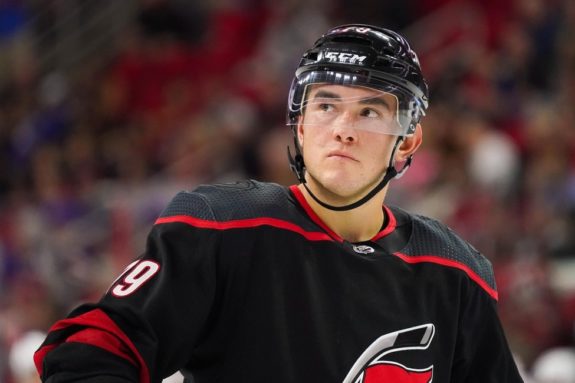On their way to unexpectedly leading the Western Conference, the Calgary Flames have leaned on five dominant 50-point players: Johnny Gaudreau, Sean Monahan, Matthew Tkachuk, Elias Lindholm and Mark Giordano. Meanwhile, their secondary scoring is another question.
Their bottom-six has been inconsistent, coach Bill Peters has yet to find a second-line right winger he likes and James Neal’s struggles have been well documented. While the Flames’ stars are the main reason for their unexpected success, it is still an open question whether they can roll four lines against the best in the league. An aggressive trade-deadline mindset is justified.
To that end, here are five top-nine forwards known to be potentially available, and the pros and cons of each.
Zuccarello or Hayes: Intriguing Rangers Rentals
Six points out of a wild-card spot and rebuilding, the New York Rangers will be sellers. Either Zuccarello or Hayes, both on-pace for 50 points, would be decent adds. Hayes would have the clear edge in age, versatility (the ability to play center), better underlying numbers and, for many Flames fans, being the one that got away.
When Hayes was a sought-after college free agent in the summer of 2014, many thought he would rejoin Gaudreau in Calgary, especially since his other Boston College linemate (Bill Arnold) was also in the Flames system at the time. Instead, he signed with the Rangers.

Insiders suggest that Hayes will cost slightly more than Zuccarello. Elliotte Friedman reported recently that the Rangers would want a second-rounder and a prospect for Zuccarello — this would be based on the Michael Grabner trade last season, which fetched the Rangers the same package. Dan Rosen reports that the Rangers could get “at least a first-round pick for Hayes, and at least a second-round pick for Zuccarello.” Given the Flames’ low projected draft position, this seems highly affordable.
Micheal Ferland: Return Home?
It would be a bizarre full-circle ending to the Flames–Carolina Hurricanes blockbuster last June if Ferland was reacquired by Calgary. Rumors are, in fact, pointing that way. The main advantage of Ferland would be familiarity, of course. His performance in the 2015 Playoffs against the Vancouver Canucks gave him fan-favorite status. In that series, Ferland’s physical presence provoked Kevin Bieksa to claim he was “irrelevant;” Ferland later helped eliminate the Canucks in Game 6 with a three-point performance.

When the Flames moved him, he was the top-line right winger by default, a role he was not consistent enough to justify. He would fit in better on a return, with the ability to move up and down the lineup as needed.
The problem, in terms of price, is that Ferland is no longer a hidden gem. Teams now know he is the rare tough-as-nails player who can also provide offense. The former Flames’ project is now the subject of notable trade chatter. Pierre LeBrun recently reported in The Athletic that the Hurricanes want “at least a first-round pick as part of a Ferland deal or at least a young player that resembles equal worth to a first-round pick” (from “LeBrun Notebook: NHL trade landscape after Muzzin deal, preparing for a Panarin exit and a Matthews extension” – The Athletic NHL – 1/30/19.)
Should Ferland return, the Flames may have to pay a premium simply for familiarity. On the other hand, he could be the missing piece without the risk of disrupting team chemistry.
Jacob Silfverberg: Trading With a Rival?
The Anaheim Ducks are facing a re-sign-or-trade scenario with Silfverberg. Unlike the others on this list, the Flames’ impediment to acquiring the two-way winger may not be cost but geography.
With teams coveting Silfverberg, especially for his strong playoff performances, the Ducks would have the leverage to charge the divisional rival Flames more, something they should probably do anyway. If the Ducks manage to crawl their way into a playoff spot, it is likely they would play the Flames in the first round.

Silfverberg has been more productive in his career than Ferland, and has played much tougher minutes: just 38.7 percent offensive zone starts this season, compared to Ferland’s 61.7 percent. However, if the divisional-rival tax kicks in, Calgary should look elsewhere for a forward.
Mark Stone: Swinging for the Fences
Except for Artemi Panarin, there is no rental forward potentially available with a higher impact – and higher probable cost – than Mark Stone. The Ottawa Senators star seems more likely to be traded than Panarin. For a team already with a league-leading five 50-point players, renting another one would truly signal this team is going for it, for better or worse.
Players of Stone’s caliber rarely become available, even as rentals. There is not much precedent, but we can assume that in addition to Calgary’s first-round pick, the Senators would want one or more legitimate blue-chip prospects as well as at least one roster player.

The fact that tanking is a meaningless exercise for Ottawa this season (because the Colorado Avalanche own their first-round pick) may make acquiring decent roster players more of a priority.
A deal might include some combination of Oliver Kylington, Rasmus Andersson, Juuso Valimaki, a prospect, a first-round pick, conditional draft picks based on how deep Calgary gets in the playoffs and/or one or two other roster players. Stone doesn’t have quite the value of Erik Karlsson, but the Senators are likely going to attempt a slightly scaled down version of that trade.
Paying that price for a few months of Stone would be high-risk and out-of-character for GM Brad Treliving, whose high-profile trades have always been for long-term players. But with Stone’s brother Michael already on the team, and Ottawa and Calgary being frequent trade partners (three deals since 2016), one has to wonder if it is that implausible.
The Flames Should Be Aggressive
Even if they don’t make the biggest splash, the Flames are clearly in a buyer’s position.
The team has made it out of the first round just twice since winning their only Stanley Cup in 1989 and are off to their best start since that season. At this point, it is fair to say expectations have been raised, and an aggressive trade deadline mindset is justified. They are not the Flames of the late Darryl Sutter seasons, glorified bubble teams who mortgaged their futures on pricey deadline adds. But nor are they in the position of last season’s Washington Capitals, whose only trade deadline add before winning the Cup was depth defenseman Michael Kempny.
There is reason to think the team can make a deep playoff run, yet making marginal moves such as a left-shot depth defenseman or 39-year-old Chris Kunitz would not significantly boost their chances. With their top-heavy forward group, adding a notable forward to the top-nine should be a priority. After years of rebuilding, the timing is right.